BHP's Corporate Planning: An Analysis of Enterprise Risk Management
VerifiedAdded on 2023/04/11
|12
|3254
|225
Report
AI Summary
This report provides an overview of BHP's enterprise risk management framework and its integration with the corporate planning process. It highlights BHP's strategic objective to leverage its capabilities and resources to meet market needs and create long-term value. The report details the components of BHP's risk management framework, including internal environment, objective setting, risk identification, risk assessment, risk response, control activities, information and communication, and independent monitoring. It also discusses BHP's risk appetite, governance structure, and the role of the Risk and Audit Committee. Furthermore, the report examines BHP's approach to risk identification, categorization, and assessment, including the use of scenario planning and signals tracking to mitigate potential impacts on the business. The document emphasizes the importance of risk management in achieving BHP's corporate purpose and ensuring the long-term sustainability of its operations and shareholder value. Desklib offers a platform to explore similar solved assignments and resources for students.
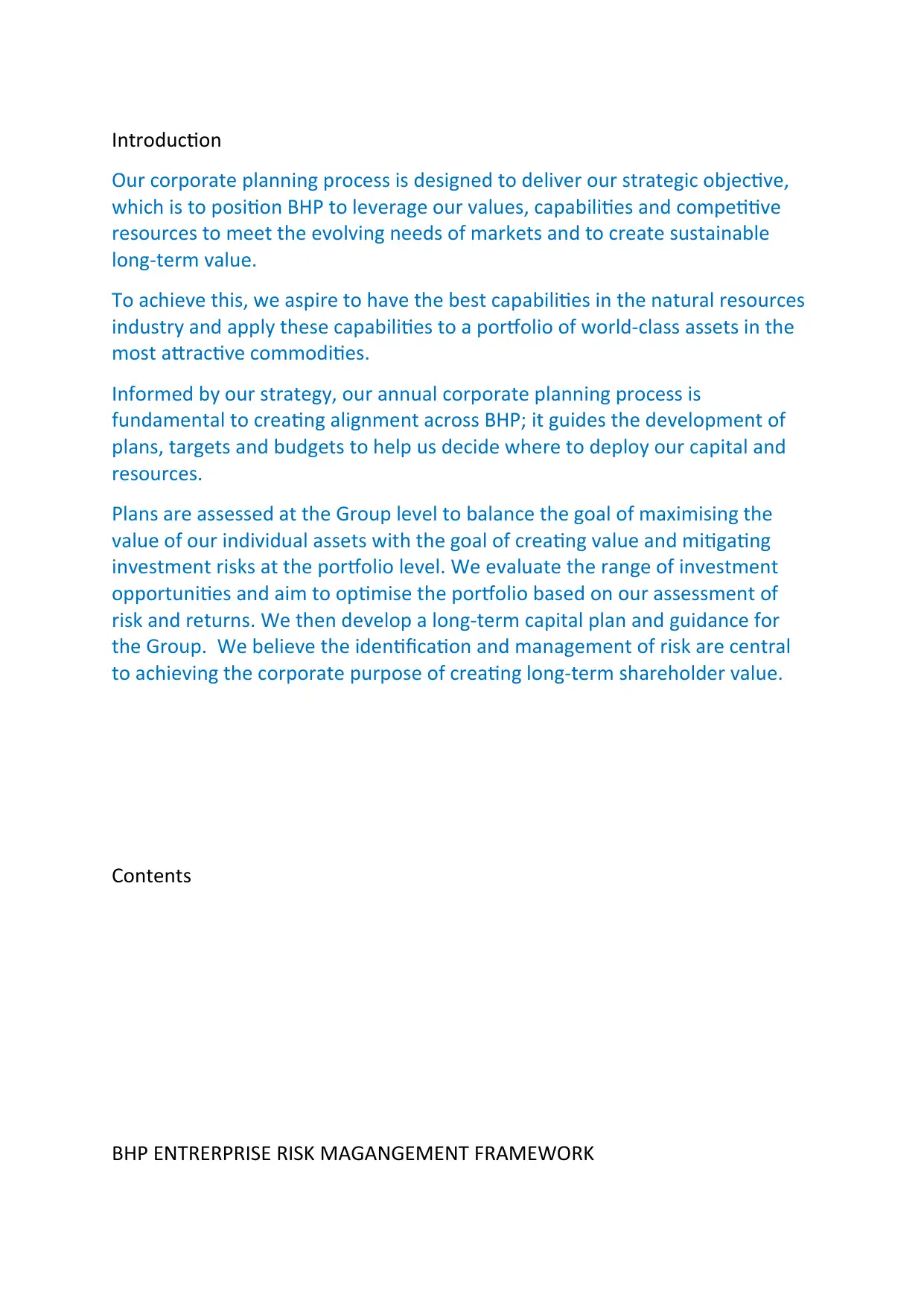
Introduction
Our corporate planning process is designed to deliver our strategic objective,
which is to position BHP to leverage our values, capabilities and competitive
resources to meet the evolving needs of markets and to create sustainable
long-term value.
To achieve this, we aspire to have the best capabilities in the natural resources
industry and apply these capabilities to a portfolio of world-class assets in the
most attractive commodities.
Informed by our strategy, our annual corporate planning process is
fundamental to creating alignment across BHP; it guides the development of
plans, targets and budgets to help us decide where to deploy our capital and
resources.
Plans are assessed at the Group level to balance the goal of maximising the
value of our individual assets with the goal of creating value and mitigating
investment risks at the portfolio level. We evaluate the range of investment
opportunities and aim to optimise the portfolio based on our assessment of
risk and returns. We then develop a long-term capital plan and guidance for
the Group. We believe the identification and management of risk are central
to achieving the corporate purpose of creating long-term shareholder value.
Contents
BHP ENTRERPRISE RISK MAGANGEMENT FRAMEWORK
Our corporate planning process is designed to deliver our strategic objective,
which is to position BHP to leverage our values, capabilities and competitive
resources to meet the evolving needs of markets and to create sustainable
long-term value.
To achieve this, we aspire to have the best capabilities in the natural resources
industry and apply these capabilities to a portfolio of world-class assets in the
most attractive commodities.
Informed by our strategy, our annual corporate planning process is
fundamental to creating alignment across BHP; it guides the development of
plans, targets and budgets to help us decide where to deploy our capital and
resources.
Plans are assessed at the Group level to balance the goal of maximising the
value of our individual assets with the goal of creating value and mitigating
investment risks at the portfolio level. We evaluate the range of investment
opportunities and aim to optimise the portfolio based on our assessment of
risk and returns. We then develop a long-term capital plan and guidance for
the Group. We believe the identification and management of risk are central
to achieving the corporate purpose of creating long-term shareholder value.
Contents
BHP ENTRERPRISE RISK MAGANGEMENT FRAMEWORK
Paraphrase This Document
Need a fresh take? Get an instant paraphrase of this document with our AI Paraphraser
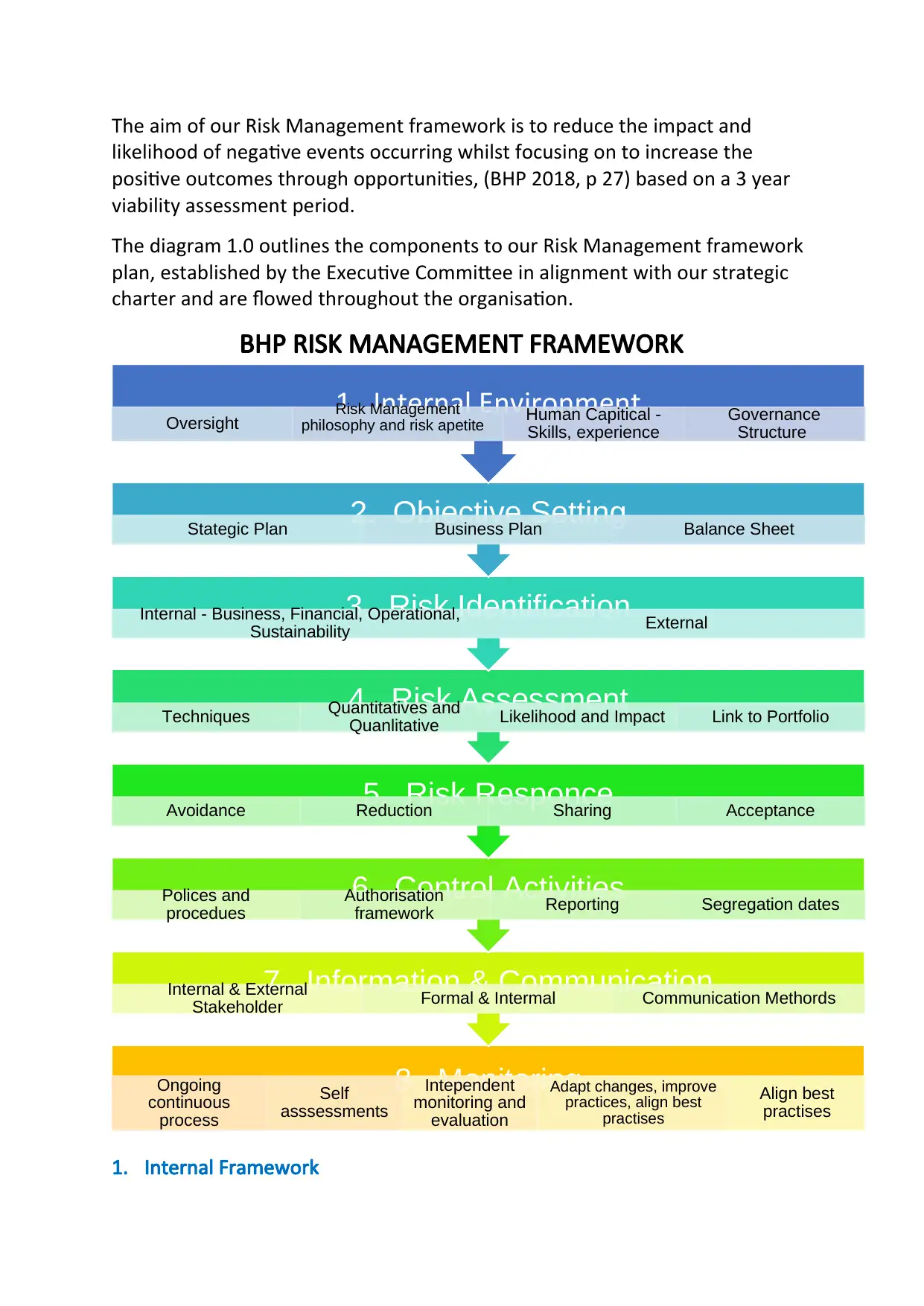
The aim of our Risk Management framework is to reduce the impact and
likelihood of negative events occurring whilst focusing on to increase the
positive outcomes through opportunities, (BHP 2018, p 27) based on a 3 year
viability assessment period.
The diagram 1.0 outlines the components to our Risk Management framework
plan, established by the Executive Committee in alignment with our strategic
charter and are flowed throughout the organisation.
BHP RISK MANAGEMENT FRAMEWORK
1. Internal Framework
8. MonitoringOngoing
continuous
process
Self
asssessments
Intependent
monitoring and
evaluation
Adapt changes, improve
practices, align best
practises
Align best
practises
7. Information & CommunicationInternal & External
Stakeholder Formal & Intermal Communication Methords
6. Control ActivitiesPolices and
procedues
Authorisation
framework Reporting Segregation dates
5. Risk ResponceAvoidance Reduction Sharing Acceptance
4. Risk AssessmentTechniques Quantitatives and
Quanlitative Likelihood and Impact Link to Portfolio
3. Risk IdentificationInternal - Business, Financial, Operational,
Sustainability External
2. Objective SettingStategic Plan Business Plan Balance Sheet
1. Internal Environment
Oversight Risk Management
philosophy and risk apetite Human Capitical -
Skills, experience
Governance
Structure
likelihood of negative events occurring whilst focusing on to increase the
positive outcomes through opportunities, (BHP 2018, p 27) based on a 3 year
viability assessment period.
The diagram 1.0 outlines the components to our Risk Management framework
plan, established by the Executive Committee in alignment with our strategic
charter and are flowed throughout the organisation.
BHP RISK MANAGEMENT FRAMEWORK
1. Internal Framework
8. MonitoringOngoing
continuous
process
Self
asssessments
Intependent
monitoring and
evaluation
Adapt changes, improve
practices, align best
practises
Align best
practises
7. Information & CommunicationInternal & External
Stakeholder Formal & Intermal Communication Methords
6. Control ActivitiesPolices and
procedues
Authorisation
framework Reporting Segregation dates
5. Risk ResponceAvoidance Reduction Sharing Acceptance
4. Risk AssessmentTechniques Quantitatives and
Quanlitative Likelihood and Impact Link to Portfolio
3. Risk IdentificationInternal - Business, Financial, Operational,
Sustainability External
2. Objective SettingStategic Plan Business Plan Balance Sheet
1. Internal Environment
Oversight Risk Management
philosophy and risk apetite Human Capitical -
Skills, experience
Governance
Structure
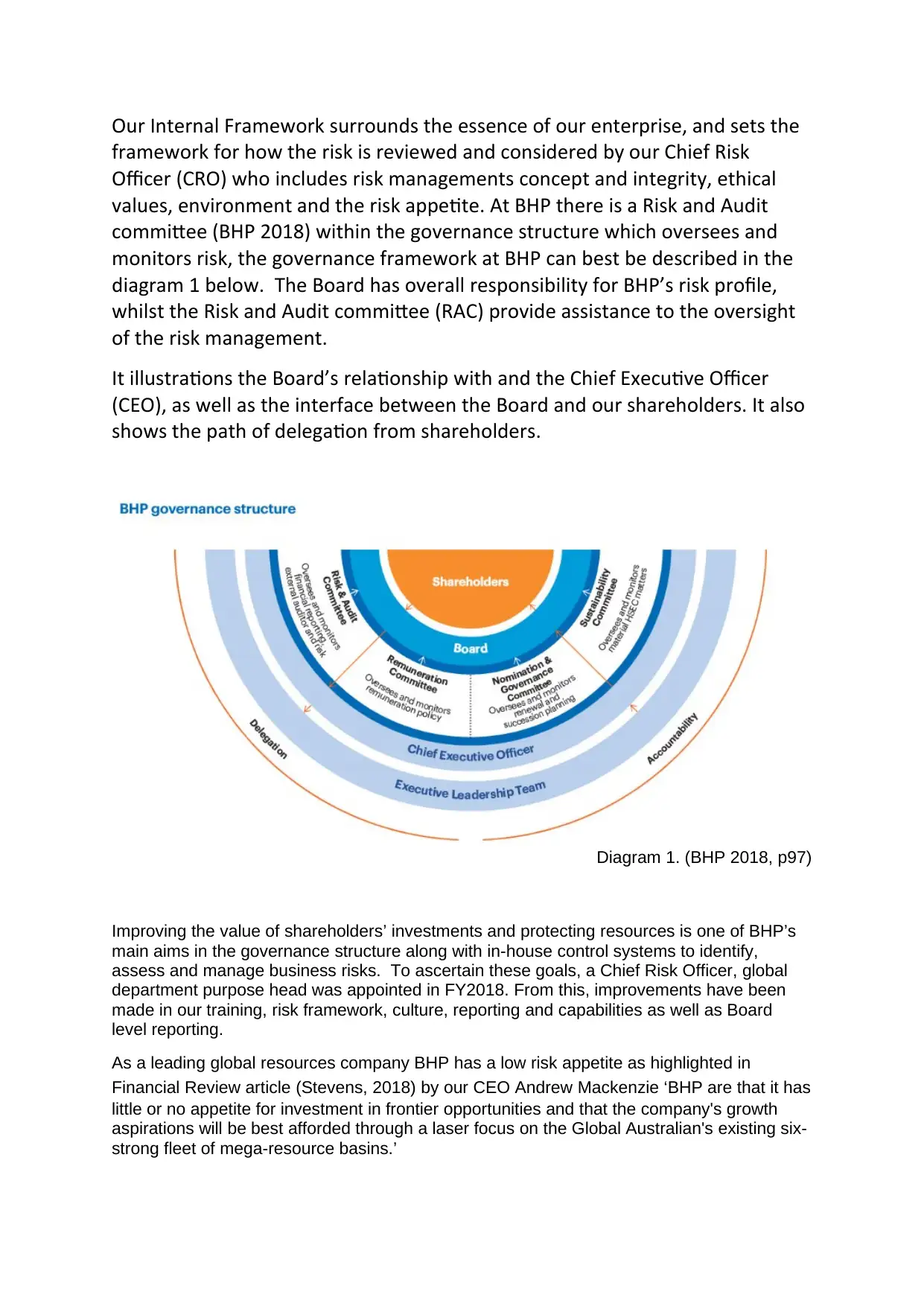
Our Internal Framework surrounds the essence of our enterprise, and sets the
framework for how the risk is reviewed and considered by our Chief Risk
Officer (CRO) who includes risk managements concept and integrity, ethical
values, environment and the risk appetite. At BHP there is a Risk and Audit
committee (BHP 2018) within the governance structure which oversees and
monitors risk, the governance framework at BHP can best be described in the
diagram 1 below. The Board has overall responsibility for BHP’s risk profile,
whilst the Risk and Audit committee (RAC) provide assistance to the oversight
of the risk management.
It illustrations the Board’s relationship with and the Chief Executive Officer
(CEO), as well as the interface between the Board and our shareholders. It also
shows the path of delegation from shareholders.
Diagram 1. (BHP 2018, p97)
Improving the value of shareholders’ investments and protecting resources is one of BHP’s
main aims in the governance structure along with in-house control systems to identify,
assess and manage business risks. To ascertain these goals, a Chief Risk Officer, global
department purpose head was appointed in FY2018. From this, improvements have been
made in our training, risk framework, culture, reporting and capabilities as well as Board
level reporting.
As a leading global resources company BHP has a low risk appetite as highlighted in
Financial Review article (Stevens, 2018) by our CEO Andrew Mackenzie ‘BHP are that it has
little or no appetite for investment in frontier opportunities and that the company's growth
aspirations will be best afforded through a laser focus on the Global Australian's existing six-
strong fleet of mega-resource basins.’
framework for how the risk is reviewed and considered by our Chief Risk
Officer (CRO) who includes risk managements concept and integrity, ethical
values, environment and the risk appetite. At BHP there is a Risk and Audit
committee (BHP 2018) within the governance structure which oversees and
monitors risk, the governance framework at BHP can best be described in the
diagram 1 below. The Board has overall responsibility for BHP’s risk profile,
whilst the Risk and Audit committee (RAC) provide assistance to the oversight
of the risk management.
It illustrations the Board’s relationship with and the Chief Executive Officer
(CEO), as well as the interface between the Board and our shareholders. It also
shows the path of delegation from shareholders.
Diagram 1. (BHP 2018, p97)
Improving the value of shareholders’ investments and protecting resources is one of BHP’s
main aims in the governance structure along with in-house control systems to identify,
assess and manage business risks. To ascertain these goals, a Chief Risk Officer, global
department purpose head was appointed in FY2018. From this, improvements have been
made in our training, risk framework, culture, reporting and capabilities as well as Board
level reporting.
As a leading global resources company BHP has a low risk appetite as highlighted in
Financial Review article (Stevens, 2018) by our CEO Andrew Mackenzie ‘BHP are that it has
little or no appetite for investment in frontier opportunities and that the company's growth
aspirations will be best afforded through a laser focus on the Global Australian's existing six-
strong fleet of mega-resource basins.’
⊘ This is a preview!⊘
Do you want full access?
Subscribe today to unlock all pages.

Trusted by 1+ million students worldwide
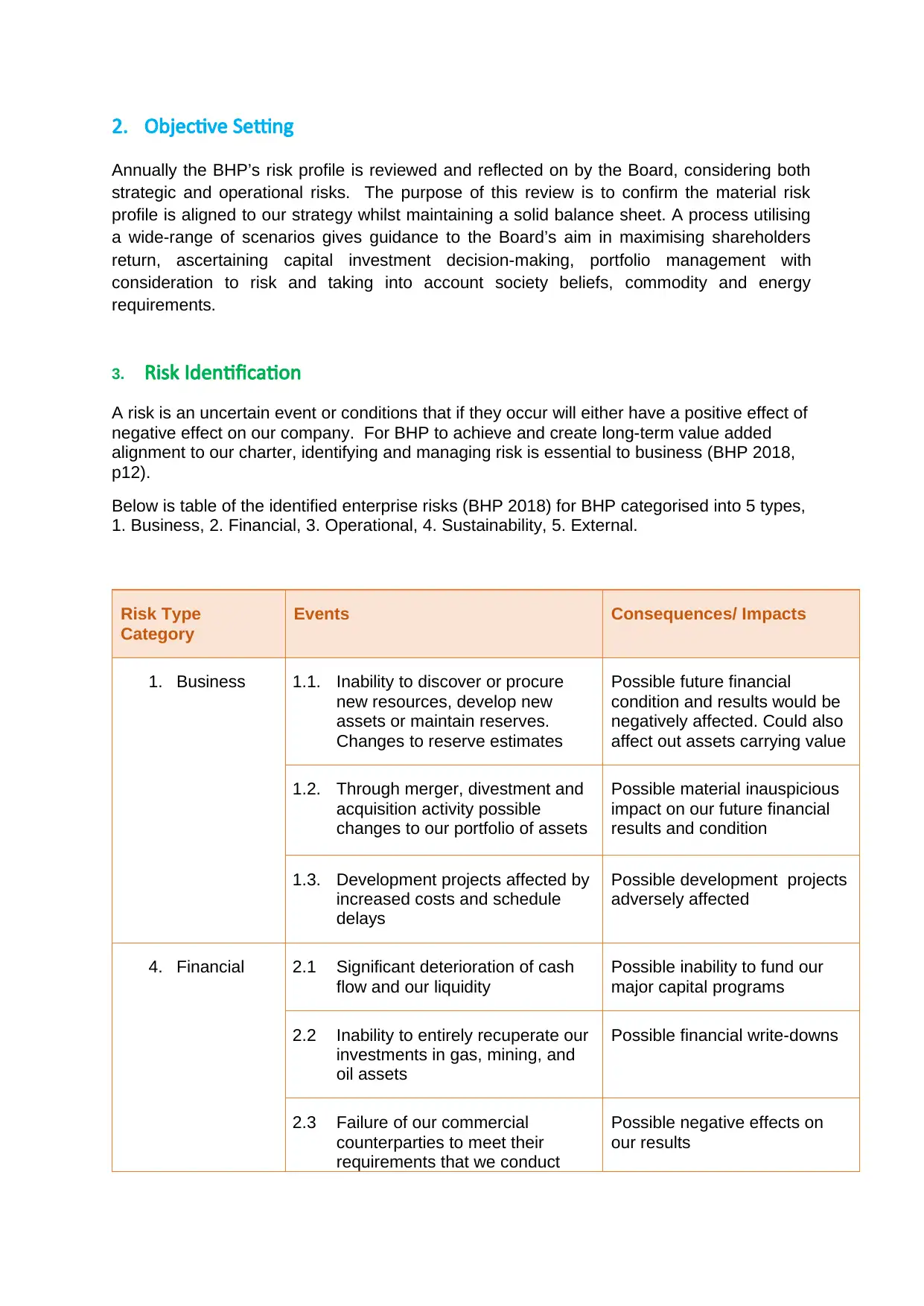
2. Objective Setting
Annually the BHP’s risk profile is reviewed and reflected on by the Board, considering both
strategic and operational risks. The purpose of this review is to confirm the material risk
profile is aligned to our strategy whilst maintaining a solid balance sheet. A process utilising
a wide-range of scenarios gives guidance to the Board’s aim in maximising shareholders
return, ascertaining capital investment decision-making, portfolio management with
consideration to risk and taking into account society beliefs, commodity and energy
requirements.
3. Risk Identification
A risk is an uncertain event or conditions that if they occur will either have a positive effect of
negative effect on our company. For BHP to achieve and create long-term value added
alignment to our charter, identifying and managing risk is essential to business (BHP 2018,
p12).
Below is table of the identified enterprise risks (BHP 2018) for BHP categorised into 5 types,
1. Business, 2. Financial, 3. Operational, 4. Sustainability, 5. External.
Risk Type
Category
Events Consequences/ Impacts
1. Business 1.1. Inability to discover or procure
new resources, develop new
assets or maintain reserves.
Changes to reserve estimates
Possible future financial
condition and results would be
negatively affected. Could also
affect out assets carrying value
1.2. Through merger, divestment and
acquisition activity possible
changes to our portfolio of assets
Possible material inauspicious
impact on our future financial
results and condition
1.3. Development projects affected by
increased costs and schedule
delays
Possible development projects
adversely affected
4. Financial 2.1 Significant deterioration of cash
flow and our liquidity
Possible inability to fund our
major capital programs
2.2 Inability to entirely recuperate our
investments in gas, mining, and
oil assets
Possible financial write-downs
2.3 Failure of our commercial
counterparties to meet their
requirements that we conduct
Possible negative effects on
our results
Annually the BHP’s risk profile is reviewed and reflected on by the Board, considering both
strategic and operational risks. The purpose of this review is to confirm the material risk
profile is aligned to our strategy whilst maintaining a solid balance sheet. A process utilising
a wide-range of scenarios gives guidance to the Board’s aim in maximising shareholders
return, ascertaining capital investment decision-making, portfolio management with
consideration to risk and taking into account society beliefs, commodity and energy
requirements.
3. Risk Identification
A risk is an uncertain event or conditions that if they occur will either have a positive effect of
negative effect on our company. For BHP to achieve and create long-term value added
alignment to our charter, identifying and managing risk is essential to business (BHP 2018,
p12).
Below is table of the identified enterprise risks (BHP 2018) for BHP categorised into 5 types,
1. Business, 2. Financial, 3. Operational, 4. Sustainability, 5. External.
Risk Type
Category
Events Consequences/ Impacts
1. Business 1.1. Inability to discover or procure
new resources, develop new
assets or maintain reserves.
Changes to reserve estimates
Possible future financial
condition and results would be
negatively affected. Could also
affect out assets carrying value
1.2. Through merger, divestment and
acquisition activity possible
changes to our portfolio of assets
Possible material inauspicious
impact on our future financial
results and condition
1.3. Development projects affected by
increased costs and schedule
delays
Possible development projects
adversely affected
4. Financial 2.1 Significant deterioration of cash
flow and our liquidity
Possible inability to fund our
major capital programs
2.2 Inability to entirely recuperate our
investments in gas, mining, and
oil assets
Possible financial write-downs
2.3 Failure of our commercial
counterparties to meet their
requirements that we conduct
Possible negative effects on
our results
Paraphrase This Document
Need a fresh take? Get an instant paraphrase of this document with our AI Paraphraser
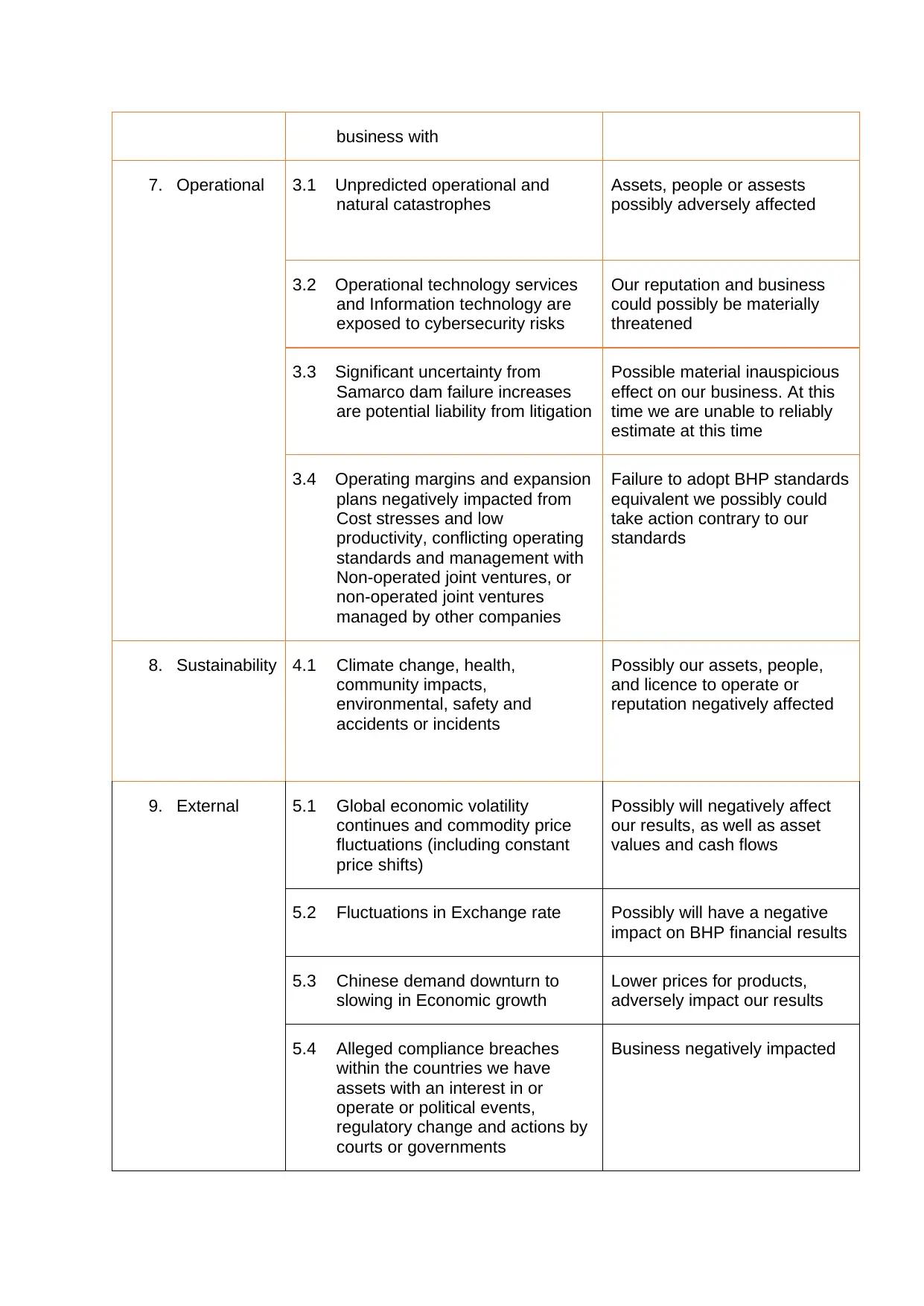
business with
7. Operational 3.1 Unpredicted operational and
natural catastrophes
Assets, people or assests
possibly adversely affected
3.2 Operational technology services
and Information technology are
exposed to cybersecurity risks
Our reputation and business
could possibly be materially
threatened
3.3 Significant uncertainty from
Samarco dam failure increases
are potential liability from litigation
Possible material inauspicious
effect on our business. At this
time we are unable to reliably
estimate at this time
3.4 Operating margins and expansion
plans negatively impacted from
Cost stresses and low
productivity, conflicting operating
standards and management with
Non-operated joint ventures, or
non-operated joint ventures
managed by other companies
Failure to adopt BHP standards
equivalent we possibly could
take action contrary to our
standards
8. Sustainability 4.1 Climate change, health,
community impacts,
environmental, safety and
accidents or incidents
Possibly our assets, people,
and licence to operate or
reputation negatively affected
9. External 5.1 Global economic volatility
continues and commodity price
fluctuations (including constant
price shifts)
Possibly will negatively affect
our results, as well as asset
values and cash flows
5.2 Fluctuations in Exchange rate Possibly will have a negative
impact on BHP financial results
5.3 Chinese demand downturn to
slowing in Economic growth
Lower prices for products,
adversely impact our results
5.4 Alleged compliance breaches
within the countries we have
assets with an interest in or
operate or political events,
regulatory change and actions by
courts or governments
Business negatively impacted
7. Operational 3.1 Unpredicted operational and
natural catastrophes
Assets, people or assests
possibly adversely affected
3.2 Operational technology services
and Information technology are
exposed to cybersecurity risks
Our reputation and business
could possibly be materially
threatened
3.3 Significant uncertainty from
Samarco dam failure increases
are potential liability from litigation
Possible material inauspicious
effect on our business. At this
time we are unable to reliably
estimate at this time
3.4 Operating margins and expansion
plans negatively impacted from
Cost stresses and low
productivity, conflicting operating
standards and management with
Non-operated joint ventures, or
non-operated joint ventures
managed by other companies
Failure to adopt BHP standards
equivalent we possibly could
take action contrary to our
standards
8. Sustainability 4.1 Climate change, health,
community impacts,
environmental, safety and
accidents or incidents
Possibly our assets, people,
and licence to operate or
reputation negatively affected
9. External 5.1 Global economic volatility
continues and commodity price
fluctuations (including constant
price shifts)
Possibly will negatively affect
our results, as well as asset
values and cash flows
5.2 Fluctuations in Exchange rate Possibly will have a negative
impact on BHP financial results
5.3 Chinese demand downturn to
slowing in Economic growth
Lower prices for products,
adversely impact our results
5.4 Alleged compliance breaches
within the countries we have
assets with an interest in or
operate or political events,
regulatory change and actions by
courts or governments
Business negatively impacted
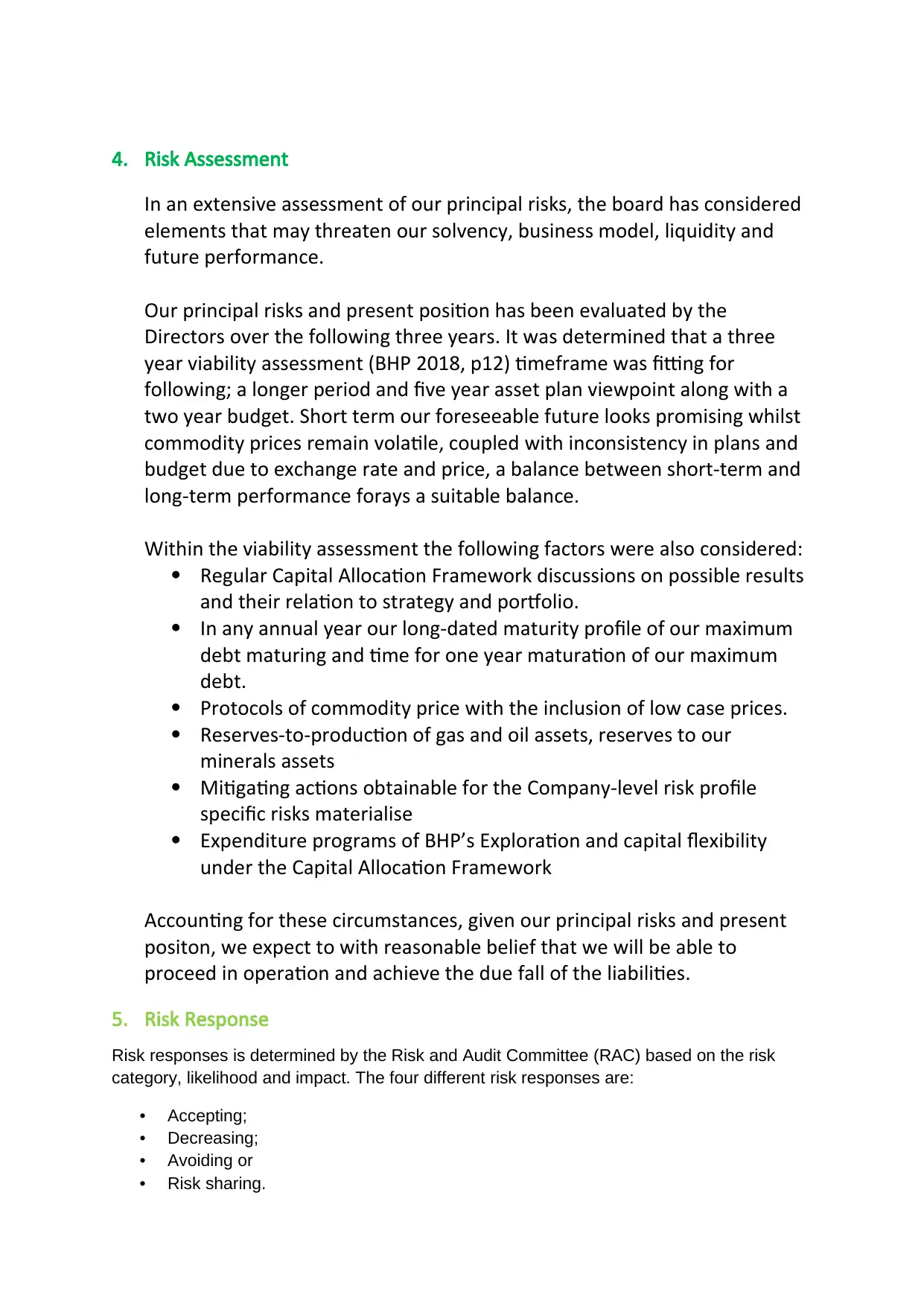
4. Risk Assessment
In an extensive assessment of our principal risks, the board has considered
elements that may threaten our solvency, business model, liquidity and
future performance.
Our principal risks and present position has been evaluated by the
Directors over the following three years. It was determined that a three
year viability assessment (BHP 2018, p12) timeframe was fitting for
following; a longer period and five year asset plan viewpoint along with a
two year budget. Short term our foreseeable future looks promising whilst
commodity prices remain volatile, coupled with inconsistency in plans and
budget due to exchange rate and price, a balance between short-term and
long-term performance forays a suitable balance.
Within the viability assessment the following factors were also considered:
Regular Capital Allocation Framework discussions on possible results
and their relation to strategy and portfolio.
In any annual year our long-dated maturity profile of our maximum
debt maturing and time for one year maturation of our maximum
debt.
Protocols of commodity price with the inclusion of low case prices.
Reserves-to-production of gas and oil assets, reserves to our
minerals assets
Mitigating actions obtainable for the Company-level risk profile
specific risks materialise
Expenditure programs of BHP’s Exploration and capital flexibility
under the Capital Allocation Framework
Accounting for these circumstances, given our principal risks and present
positon, we expect to with reasonable belief that we will be able to
proceed in operation and achieve the due fall of the liabilities.
5. Risk Response
Risk responses is determined by the Risk and Audit Committee (RAC) based on the risk
category, likelihood and impact. The four different risk responses are:
• Accepting;
• Decreasing;
• Avoiding or
• Risk sharing.
In an extensive assessment of our principal risks, the board has considered
elements that may threaten our solvency, business model, liquidity and
future performance.
Our principal risks and present position has been evaluated by the
Directors over the following three years. It was determined that a three
year viability assessment (BHP 2018, p12) timeframe was fitting for
following; a longer period and five year asset plan viewpoint along with a
two year budget. Short term our foreseeable future looks promising whilst
commodity prices remain volatile, coupled with inconsistency in plans and
budget due to exchange rate and price, a balance between short-term and
long-term performance forays a suitable balance.
Within the viability assessment the following factors were also considered:
Regular Capital Allocation Framework discussions on possible results
and their relation to strategy and portfolio.
In any annual year our long-dated maturity profile of our maximum
debt maturing and time for one year maturation of our maximum
debt.
Protocols of commodity price with the inclusion of low case prices.
Reserves-to-production of gas and oil assets, reserves to our
minerals assets
Mitigating actions obtainable for the Company-level risk profile
specific risks materialise
Expenditure programs of BHP’s Exploration and capital flexibility
under the Capital Allocation Framework
Accounting for these circumstances, given our principal risks and present
positon, we expect to with reasonable belief that we will be able to
proceed in operation and achieve the due fall of the liabilities.
5. Risk Response
Risk responses is determined by the Risk and Audit Committee (RAC) based on the risk
category, likelihood and impact. The four different risk responses are:
• Accepting;
• Decreasing;
• Avoiding or
• Risk sharing.
⊘ This is a preview!⊘
Do you want full access?
Subscribe today to unlock all pages.

Trusted by 1+ million students worldwide
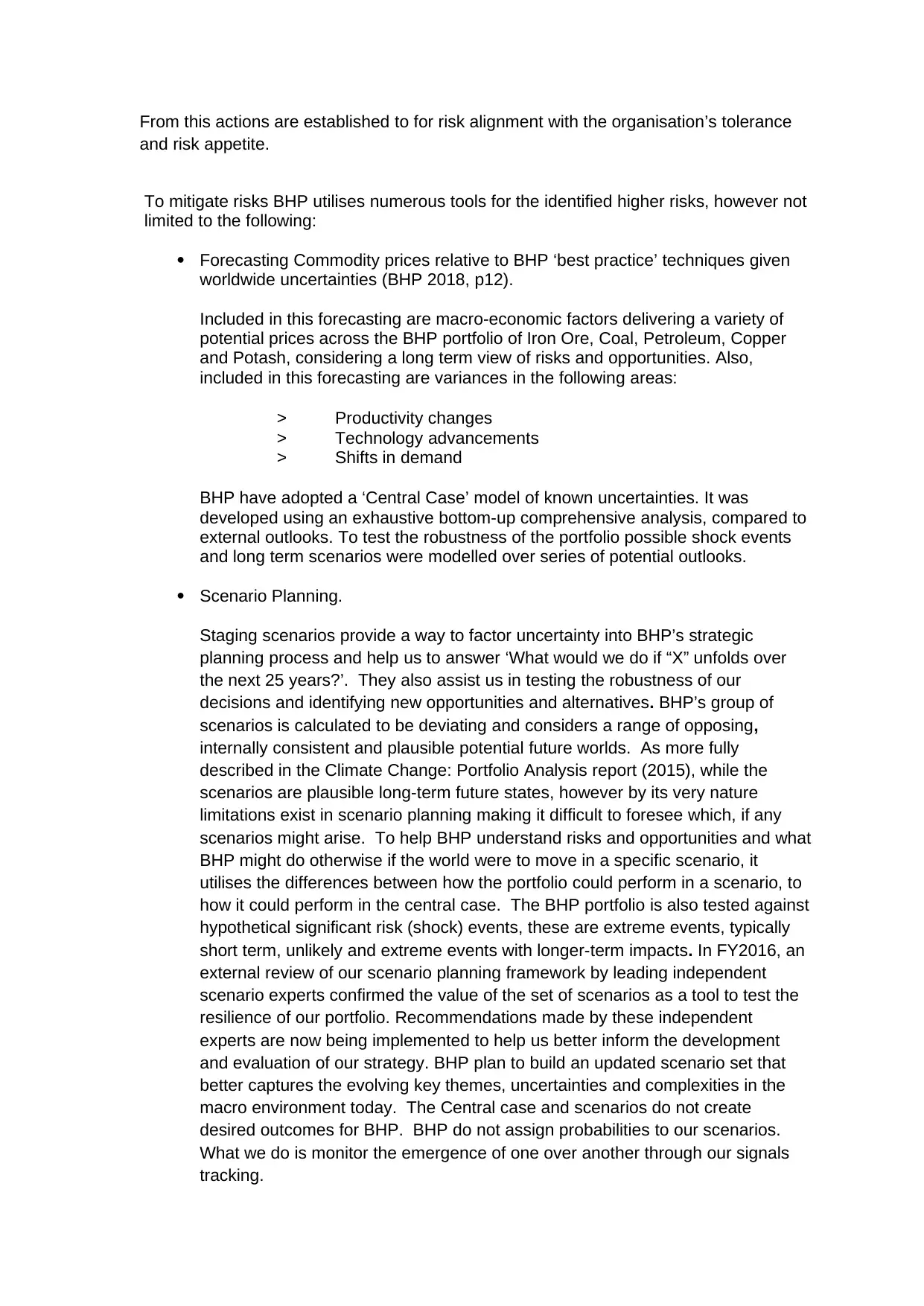
From this actions are established to for risk alignment with the organisation’s tolerance
and risk appetite.
To mitigate risks BHP utilises numerous tools for the identified higher risks, however not
limited to the following:
Forecasting Commodity prices relative to BHP ‘best practice’ techniques given
worldwide uncertainties (BHP 2018, p12).
Included in this forecasting are macro-economic factors delivering a variety of
potential prices across the BHP portfolio of Iron Ore, Coal, Petroleum, Copper
and Potash, considering a long term view of risks and opportunities. Also,
included in this forecasting are variances in the following areas:
> Productivity changes
> Technology advancements
> Shifts in demand
BHP have adopted a ‘Central Case’ model of known uncertainties. It was
developed using an exhaustive bottom-up comprehensive analysis, compared to
external outlooks. To test the robustness of the portfolio possible shock events
and long term scenarios were modelled over series of potential outlooks.
Scenario Planning.
Staging scenarios provide a way to factor uncertainty into BHP’s strategic
planning process and help us to answer ‘What would we do if “X” unfolds over
the next 25 years?’. They also assist us in testing the robustness of our
decisions and identifying new opportunities and alternatives. BHP’s group of
scenarios is calculated to be deviating and considers a range of opposing,
internally consistent and plausible potential future worlds. As more fully
described in the Climate Change: Portfolio Analysis report (2015), while the
scenarios are plausible long-term future states, however by its very nature
limitations exist in scenario planning making it difficult to foresee which, if any
scenarios might arise. To help BHP understand risks and opportunities and what
BHP might do otherwise if the world were to move in a specific scenario, it
utilises the differences between how the portfolio could perform in a scenario, to
how it could perform in the central case. The BHP portfolio is also tested against
hypothetical significant risk (shock) events, these are extreme events, typically
short term, unlikely and extreme events with longer-term impacts. In FY2016, an
external review of our scenario planning framework by leading independent
scenario experts confirmed the value of the set of scenarios as a tool to test the
resilience of our portfolio. Recommendations made by these independent
experts are now being implemented to help us better inform the development
and evaluation of our strategy. BHP plan to build an updated scenario set that
better captures the evolving key themes, uncertainties and complexities in the
macro environment today. The Central case and scenarios do not create
desired outcomes for BHP. BHP do not assign probabilities to our scenarios.
What we do is monitor the emergence of one over another through our signals
tracking.
and risk appetite.
To mitigate risks BHP utilises numerous tools for the identified higher risks, however not
limited to the following:
Forecasting Commodity prices relative to BHP ‘best practice’ techniques given
worldwide uncertainties (BHP 2018, p12).
Included in this forecasting are macro-economic factors delivering a variety of
potential prices across the BHP portfolio of Iron Ore, Coal, Petroleum, Copper
and Potash, considering a long term view of risks and opportunities. Also,
included in this forecasting are variances in the following areas:
> Productivity changes
> Technology advancements
> Shifts in demand
BHP have adopted a ‘Central Case’ model of known uncertainties. It was
developed using an exhaustive bottom-up comprehensive analysis, compared to
external outlooks. To test the robustness of the portfolio possible shock events
and long term scenarios were modelled over series of potential outlooks.
Scenario Planning.
Staging scenarios provide a way to factor uncertainty into BHP’s strategic
planning process and help us to answer ‘What would we do if “X” unfolds over
the next 25 years?’. They also assist us in testing the robustness of our
decisions and identifying new opportunities and alternatives. BHP’s group of
scenarios is calculated to be deviating and considers a range of opposing,
internally consistent and plausible potential future worlds. As more fully
described in the Climate Change: Portfolio Analysis report (2015), while the
scenarios are plausible long-term future states, however by its very nature
limitations exist in scenario planning making it difficult to foresee which, if any
scenarios might arise. To help BHP understand risks and opportunities and what
BHP might do otherwise if the world were to move in a specific scenario, it
utilises the differences between how the portfolio could perform in a scenario, to
how it could perform in the central case. The BHP portfolio is also tested against
hypothetical significant risk (shock) events, these are extreme events, typically
short term, unlikely and extreme events with longer-term impacts. In FY2016, an
external review of our scenario planning framework by leading independent
scenario experts confirmed the value of the set of scenarios as a tool to test the
resilience of our portfolio. Recommendations made by these independent
experts are now being implemented to help us better inform the development
and evaluation of our strategy. BHP plan to build an updated scenario set that
better captures the evolving key themes, uncertainties and complexities in the
macro environment today. The Central case and scenarios do not create
desired outcomes for BHP. BHP do not assign probabilities to our scenarios.
What we do is monitor the emergence of one over another through our signals
tracking.
Paraphrase This Document
Need a fresh take? Get an instant paraphrase of this document with our AI Paraphraser
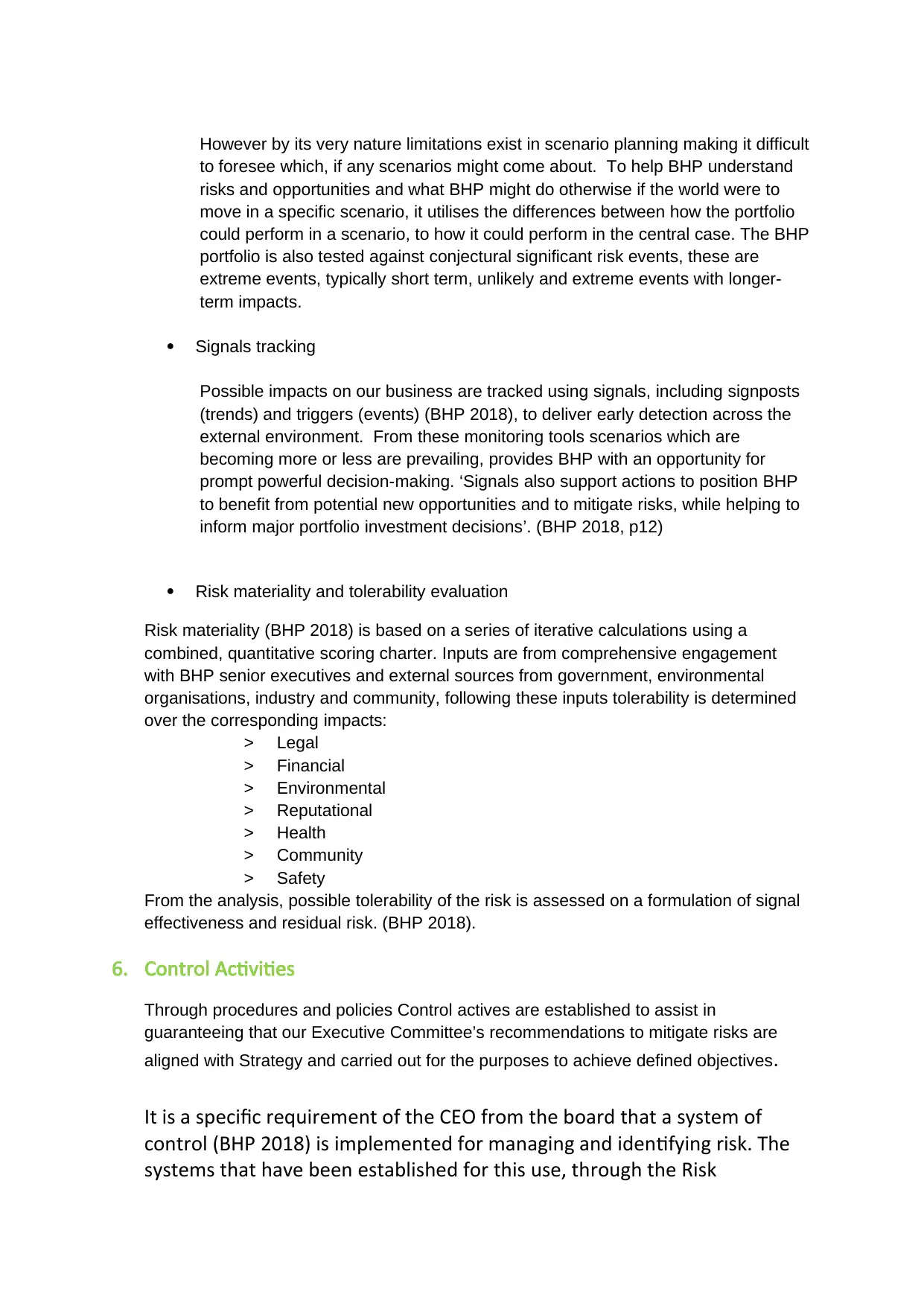
However by its very nature limitations exist in scenario planning making it difficult
to foresee which, if any scenarios might come about. To help BHP understand
risks and opportunities and what BHP might do otherwise if the world were to
move in a specific scenario, it utilises the differences between how the portfolio
could perform in a scenario, to how it could perform in the central case. The BHP
portfolio is also tested against conjectural significant risk events, these are
extreme events, typically short term, unlikely and extreme events with longer-
term impacts.
Signals tracking
Possible impacts on our business are tracked using signals, including signposts
(trends) and triggers (events) (BHP 2018), to deliver early detection across the
external environment. From these monitoring tools scenarios which are
becoming more or less are prevailing, provides BHP with an opportunity for
prompt powerful decision-making. ‘Signals also support actions to position BHP
to benefit from potential new opportunities and to mitigate risks, while helping to
inform major portfolio investment decisions’. (BHP 2018, p12)
Risk materiality and tolerability evaluation
Risk materiality (BHP 2018) is based on a series of iterative calculations using a
combined, quantitative scoring charter. Inputs are from comprehensive engagement
with BHP senior executives and external sources from government, environmental
organisations, industry and community, following these inputs tolerability is determined
over the corresponding impacts:
> Legal
> Financial
> Environmental
> Reputational
> Health
> Community
> Safety
From the analysis, possible tolerability of the risk is assessed on a formulation of signal
effectiveness and residual risk. (BHP 2018).
6. Control Activities
Through procedures and policies Control actives are established to assist in
guaranteeing that our Executive Committee’s recommendations to mitigate risks are
aligned with Strategy and carried out for the purposes to achieve defined objectives.
It is a specific requirement of the CEO from the board that a system of
control (BHP 2018) is implemented for managing and identifying risk. The
systems that have been established for this use, through the Risk
to foresee which, if any scenarios might come about. To help BHP understand
risks and opportunities and what BHP might do otherwise if the world were to
move in a specific scenario, it utilises the differences between how the portfolio
could perform in a scenario, to how it could perform in the central case. The BHP
portfolio is also tested against conjectural significant risk events, these are
extreme events, typically short term, unlikely and extreme events with longer-
term impacts.
Signals tracking
Possible impacts on our business are tracked using signals, including signposts
(trends) and triggers (events) (BHP 2018), to deliver early detection across the
external environment. From these monitoring tools scenarios which are
becoming more or less are prevailing, provides BHP with an opportunity for
prompt powerful decision-making. ‘Signals also support actions to position BHP
to benefit from potential new opportunities and to mitigate risks, while helping to
inform major portfolio investment decisions’. (BHP 2018, p12)
Risk materiality and tolerability evaluation
Risk materiality (BHP 2018) is based on a series of iterative calculations using a
combined, quantitative scoring charter. Inputs are from comprehensive engagement
with BHP senior executives and external sources from government, environmental
organisations, industry and community, following these inputs tolerability is determined
over the corresponding impacts:
> Legal
> Financial
> Environmental
> Reputational
> Health
> Community
> Safety
From the analysis, possible tolerability of the risk is assessed on a formulation of signal
effectiveness and residual risk. (BHP 2018).
6. Control Activities
Through procedures and policies Control actives are established to assist in
guaranteeing that our Executive Committee’s recommendations to mitigate risks are
aligned with Strategy and carried out for the purposes to achieve defined objectives.
It is a specific requirement of the CEO from the board that a system of
control (BHP 2018) is implemented for managing and identifying risk. The
systems that have been established for this use, through the Risk
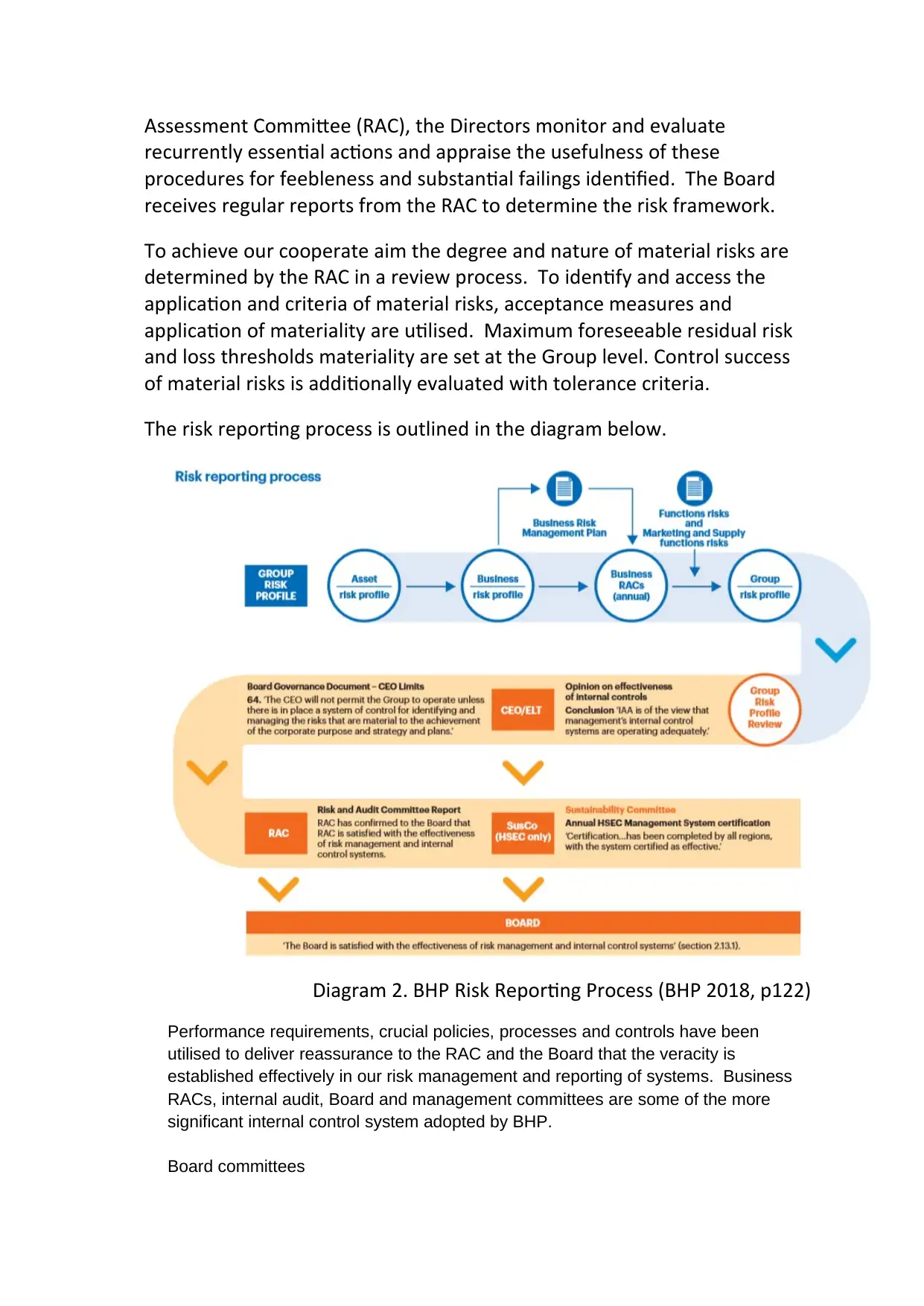
Assessment Committee (RAC), the Directors monitor and evaluate
recurrently essential actions and appraise the usefulness of these
procedures for feebleness and substantial failings identified. The Board
receives regular reports from the RAC to determine the risk framework.
To achieve our cooperate aim the degree and nature of material risks are
determined by the RAC in a review process. To identify and access the
application and criteria of material risks, acceptance measures and
application of materiality are utilised. Maximum foreseeable residual risk
and loss thresholds materiality are set at the Group level. Control success
of material risks is additionally evaluated with tolerance criteria.
The risk reporting process is outlined in the diagram below.
Diagram 2. BHP Risk Reporting Process (BHP 2018, p122)
Performance requirements, crucial policies, processes and controls have been
utilised to deliver reassurance to the RAC and the Board that the veracity is
established effectively in our risk management and reporting of systems. Business
RACs, internal audit, Board and management committees are some of the more
significant internal control system adopted by BHP.
Board committees
recurrently essential actions and appraise the usefulness of these
procedures for feebleness and substantial failings identified. The Board
receives regular reports from the RAC to determine the risk framework.
To achieve our cooperate aim the degree and nature of material risks are
determined by the RAC in a review process. To identify and access the
application and criteria of material risks, acceptance measures and
application of materiality are utilised. Maximum foreseeable residual risk
and loss thresholds materiality are set at the Group level. Control success
of material risks is additionally evaluated with tolerance criteria.
The risk reporting process is outlined in the diagram below.
Diagram 2. BHP Risk Reporting Process (BHP 2018, p122)
Performance requirements, crucial policies, processes and controls have been
utilised to deliver reassurance to the RAC and the Board that the veracity is
established effectively in our risk management and reporting of systems. Business
RACs, internal audit, Board and management committees are some of the more
significant internal control system adopted by BHP.
Board committees
⊘ This is a preview!⊘
Do you want full access?
Subscribe today to unlock all pages.

Trusted by 1+ million students worldwide
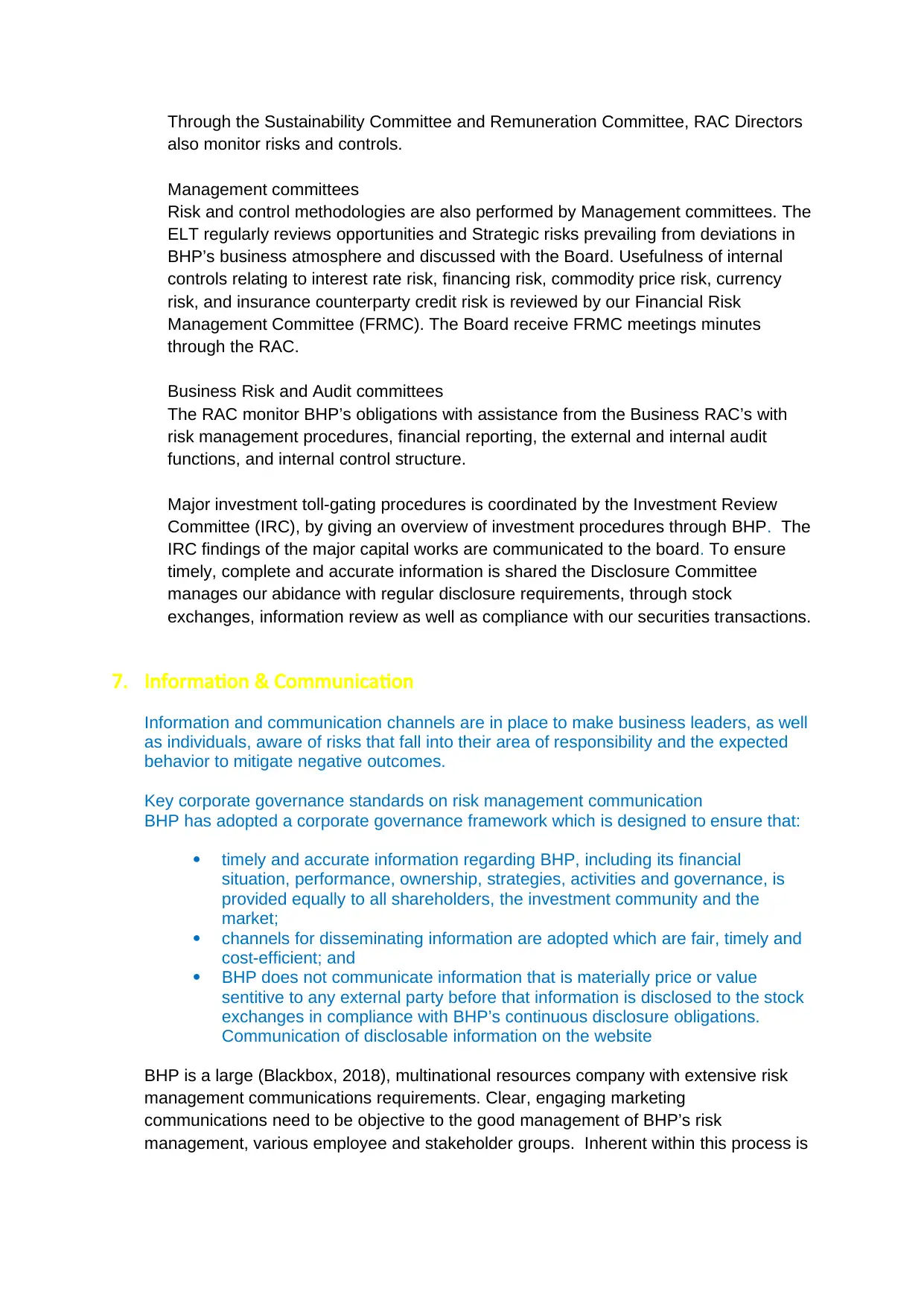
Through the Sustainability Committee and Remuneration Committee, RAC Directors
also monitor risks and controls.
Management committees
Risk and control methodologies are also performed by Management committees. The
ELT regularly reviews opportunities and Strategic risks prevailing from deviations in
BHP’s business atmosphere and discussed with the Board. Usefulness of internal
controls relating to interest rate risk, financing risk, commodity price risk, currency
risk, and insurance counterparty credit risk is reviewed by our Financial Risk
Management Committee (FRMC). The Board receive FRMC meetings minutes
through the RAC.
Business Risk and Audit committees
The RAC monitor BHP’s obligations with assistance from the Business RAC’s with
risk management procedures, financial reporting, the external and internal audit
functions, and internal control structure.
Major investment toll-gating procedures is coordinated by the Investment Review
Committee (IRC), by giving an overview of investment procedures through BHP. The
IRC findings of the major capital works are communicated to the board. To ensure
timely, complete and accurate information is shared the Disclosure Committee
manages our abidance with regular disclosure requirements, through stock
exchanges, information review as well as compliance with our securities transactions.
7. Information & Communication
Information and communication channels are in place to make business leaders, as well
as individuals, aware of risks that fall into their area of responsibility and the expected
behavior to mitigate negative outcomes.
Key corporate governance standards on risk management communication
BHP has adopted a corporate governance framework which is designed to ensure that:
timely and accurate information regarding BHP, including its financial
situation, performance, ownership, strategies, activities and governance, is
provided equally to all shareholders, the investment community and the
market;
channels for disseminating information are adopted which are fair, timely and
cost-efficient; and
BHP does not communicate information that is materially price or value
sentitive to any external party before that information is disclosed to the stock
exchanges in compliance with BHP’s continuous disclosure obligations.
Communication of disclosable information on the website
BHP is a large (Blackbox, 2018), multinational resources company with extensive risk
management communications requirements. Clear, engaging marketing
communications need to be objective to the good management of BHP’s risk
management, various employee and stakeholder groups. Inherent within this process is
also monitor risks and controls.
Management committees
Risk and control methodologies are also performed by Management committees. The
ELT regularly reviews opportunities and Strategic risks prevailing from deviations in
BHP’s business atmosphere and discussed with the Board. Usefulness of internal
controls relating to interest rate risk, financing risk, commodity price risk, currency
risk, and insurance counterparty credit risk is reviewed by our Financial Risk
Management Committee (FRMC). The Board receive FRMC meetings minutes
through the RAC.
Business Risk and Audit committees
The RAC monitor BHP’s obligations with assistance from the Business RAC’s with
risk management procedures, financial reporting, the external and internal audit
functions, and internal control structure.
Major investment toll-gating procedures is coordinated by the Investment Review
Committee (IRC), by giving an overview of investment procedures through BHP. The
IRC findings of the major capital works are communicated to the board. To ensure
timely, complete and accurate information is shared the Disclosure Committee
manages our abidance with regular disclosure requirements, through stock
exchanges, information review as well as compliance with our securities transactions.
7. Information & Communication
Information and communication channels are in place to make business leaders, as well
as individuals, aware of risks that fall into their area of responsibility and the expected
behavior to mitigate negative outcomes.
Key corporate governance standards on risk management communication
BHP has adopted a corporate governance framework which is designed to ensure that:
timely and accurate information regarding BHP, including its financial
situation, performance, ownership, strategies, activities and governance, is
provided equally to all shareholders, the investment community and the
market;
channels for disseminating information are adopted which are fair, timely and
cost-efficient; and
BHP does not communicate information that is materially price or value
sentitive to any external party before that information is disclosed to the stock
exchanges in compliance with BHP’s continuous disclosure obligations.
Communication of disclosable information on the website
BHP is a large (Blackbox, 2018), multinational resources company with extensive risk
management communications requirements. Clear, engaging marketing
communications need to be objective to the good management of BHP’s risk
management, various employee and stakeholder groups. Inherent within this process is
Paraphrase This Document
Need a fresh take? Get an instant paraphrase of this document with our AI Paraphraser
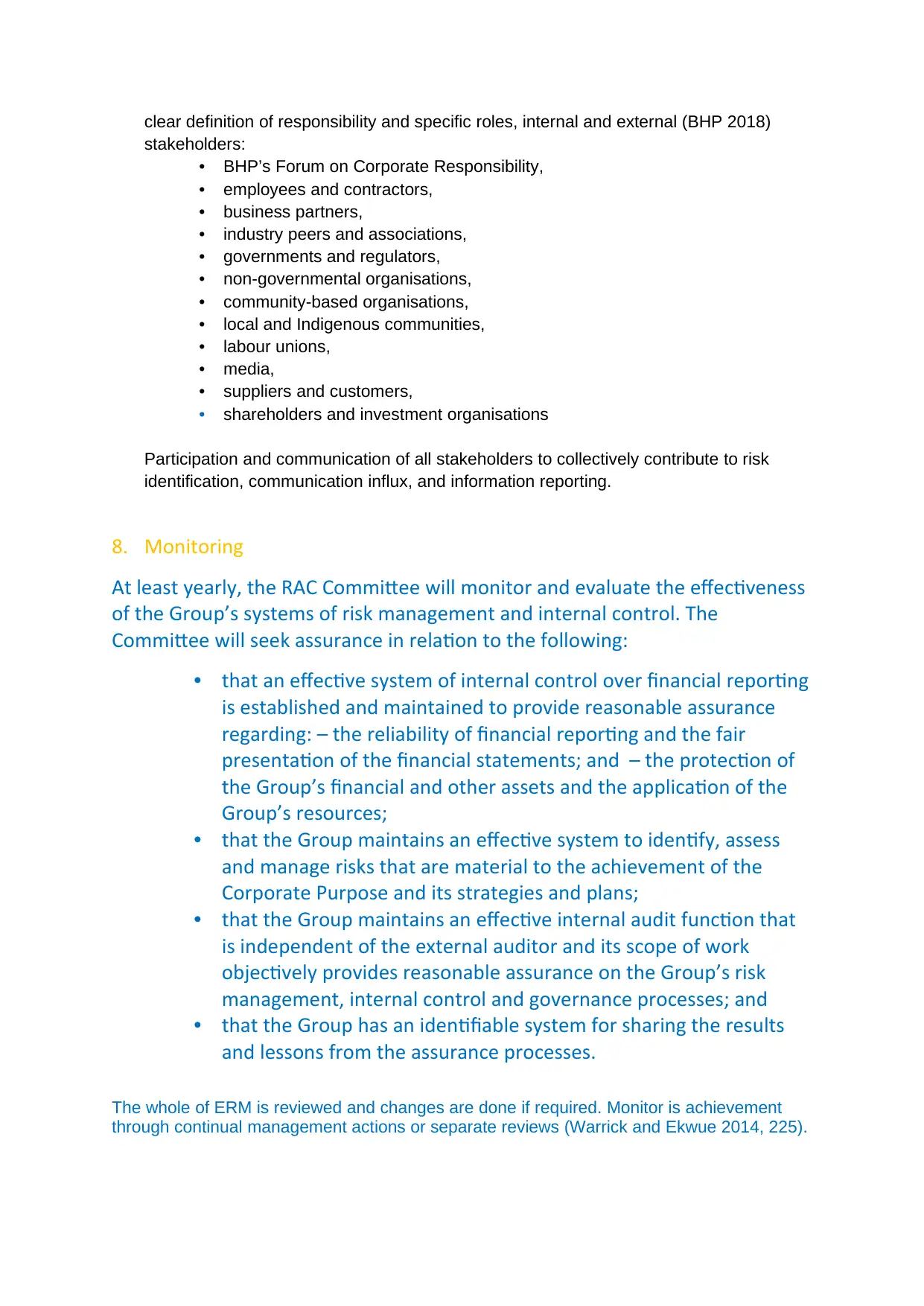
clear definition of responsibility and specific roles, internal and external (BHP 2018)
stakeholders:
• BHP’s Forum on Corporate Responsibility,
• employees and contractors,
• business partners,
• industry peers and associations,
• governments and regulators,
• non-governmental organisations,
• community-based organisations,
• local and Indigenous communities,
• labour unions,
• media,
• suppliers and customers,
• shareholders and investment organisations
Participation and communication of all stakeholders to collectively contribute to risk
identification, communication influx, and information reporting.
8. Monitoring
At least yearly, the RAC Committee will monitor and evaluate the effectiveness
of the Group’s systems of risk management and internal control. The
Committee will seek assurance in relation to the following:
• that an effective system of internal control over financial reporting
is established and maintained to provide reasonable assurance
regarding: – the reliability of financial reporting and the fair
presentation of the financial statements; and – the protection of
the Group’s financial and other assets and the application of the
Group’s resources;
• that the Group maintains an effective system to identify, assess
and manage risks that are material to the achievement of the
Corporate Purpose and its strategies and plans;
• that the Group maintains an effective internal audit function that
is independent of the external auditor and its scope of work
objectively provides reasonable assurance on the Group’s risk
management, internal control and governance processes; and
• that the Group has an identifiable system for sharing the results
and lessons from the assurance processes.
The whole of ERM is reviewed and changes are done if required. Monitor is achievement
through continual management actions or separate reviews (Warrick and Ekwue 2014, 225).
stakeholders:
• BHP’s Forum on Corporate Responsibility,
• employees and contractors,
• business partners,
• industry peers and associations,
• governments and regulators,
• non-governmental organisations,
• community-based organisations,
• local and Indigenous communities,
• labour unions,
• media,
• suppliers and customers,
• shareholders and investment organisations
Participation and communication of all stakeholders to collectively contribute to risk
identification, communication influx, and information reporting.
8. Monitoring
At least yearly, the RAC Committee will monitor and evaluate the effectiveness
of the Group’s systems of risk management and internal control. The
Committee will seek assurance in relation to the following:
• that an effective system of internal control over financial reporting
is established and maintained to provide reasonable assurance
regarding: – the reliability of financial reporting and the fair
presentation of the financial statements; and – the protection of
the Group’s financial and other assets and the application of the
Group’s resources;
• that the Group maintains an effective system to identify, assess
and manage risks that are material to the achievement of the
Corporate Purpose and its strategies and plans;
• that the Group maintains an effective internal audit function that
is independent of the external auditor and its scope of work
objectively provides reasonable assurance on the Group’s risk
management, internal control and governance processes; and
• that the Group has an identifiable system for sharing the results
and lessons from the assurance processes.
The whole of ERM is reviewed and changes are done if required. Monitor is achievement
through continual management actions or separate reviews (Warrick and Ekwue 2014, 225).
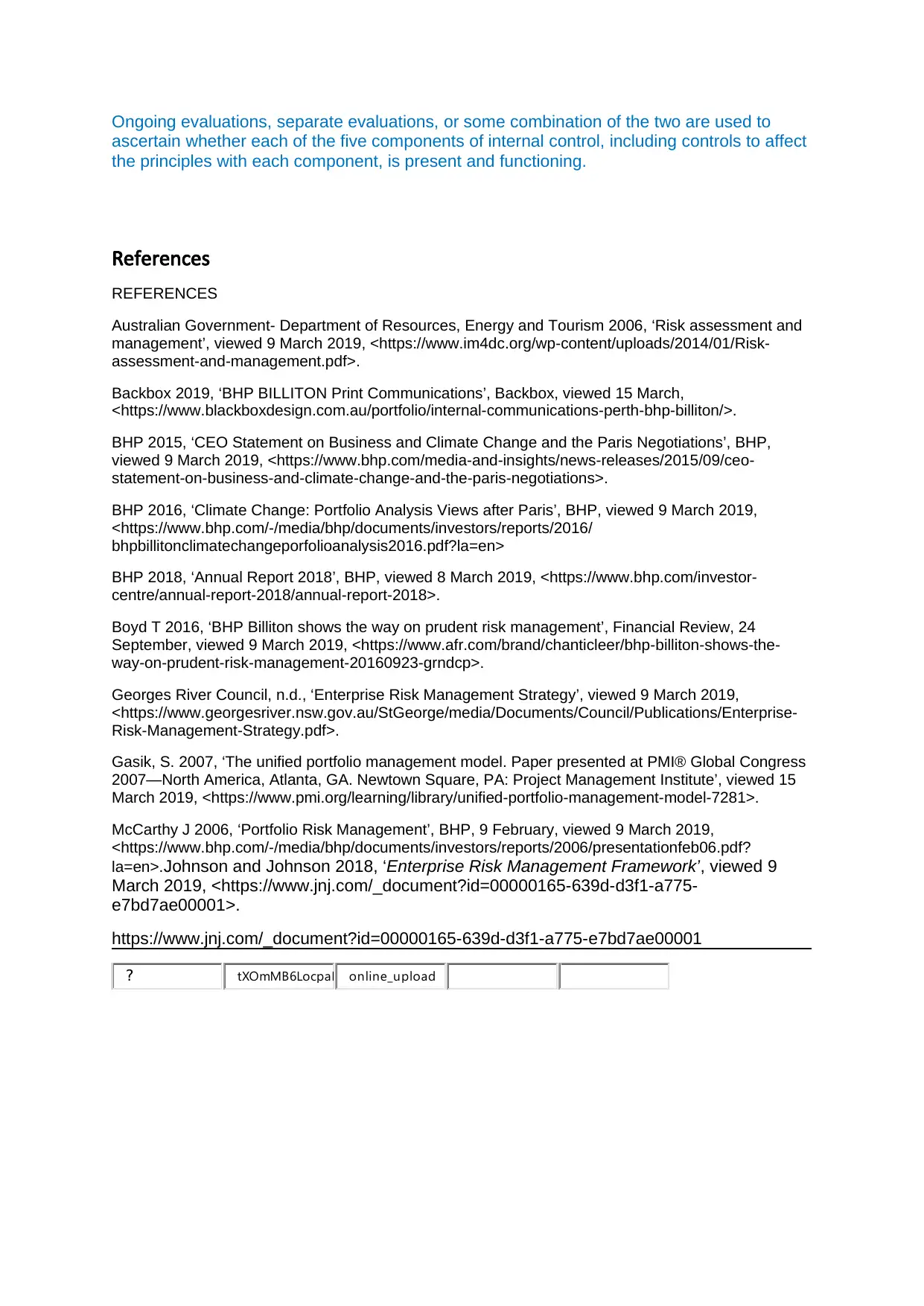
Ongoing evaluations, separate evaluations, or some combination of the two are used to
ascertain whether each of the five components of internal control, including controls to affect
the principles with each component, is present and functioning.
References
REFERENCES
Australian Government- Department of Resources, Energy and Tourism 2006, ‘Risk assessment and
management’, viewed 9 March 2019, <https://www.im4dc.org/wp-content/uploads/2014/01/Risk-
assessment-and-management.pdf>.
Backbox 2019, ‘BHP BILLITON Print Communications’, Backbox, viewed 15 March,
<https://www.blackboxdesign.com.au/portfolio/internal-communications-perth-bhp-billiton/>.
BHP 2015, ‘CEO Statement on Business and Climate Change and the Paris Negotiations’, BHP,
viewed 9 March 2019, <https://www.bhp.com/media-and-insights/news-releases/2015/09/ceo-
statement-on-business-and-climate-change-and-the-paris-negotiations>.
BHP 2016, ‘Climate Change: Portfolio Analysis Views after Paris’, BHP, viewed 9 March 2019,
<https://www.bhp.com/-/media/bhp/documents/investors/reports/2016/
bhpbillitonclimatechangeporfolioanalysis2016.pdf?la=en>
BHP 2018, ‘Annual Report 2018’, BHP, viewed 8 March 2019, <https://www.bhp.com/investor-
centre/annual-report-2018/annual-report-2018>.
Boyd T 2016, ‘BHP Billiton shows the way on prudent risk management’, Financial Review, 24
September, viewed 9 March 2019, <https://www.afr.com/brand/chanticleer/bhp-billiton-shows-the-
way-on-prudent-risk-management-20160923-grndcp>.
Georges River Council, n.d., ‘Enterprise Risk Management Strategy’, viewed 9 March 2019,
<https://www.georgesriver.nsw.gov.au/StGeorge/media/Documents/Council/Publications/Enterprise-
Risk-Management-Strategy.pdf>.
Gasik, S. 2007, ‘The unified portfolio management model. Paper presented at PMI® Global Congress
2007—North America, Atlanta, GA. Newtown Square, PA: Project Management Institute’, viewed 15
March 2019, <https://www.pmi.org/learning/library/unified-portfolio-management-model-7281>.
McCarthy J 2006, ‘Portfolio Risk Management’, BHP, 9 February, viewed 9 March 2019,
<https://www.bhp.com/-/media/bhp/documents/investors/reports/2006/presentationfeb06.pdf?
la=en>.Johnson and Johnson 2018, ‘Enterprise Risk Management Framework’, viewed 9
March 2019, <https://www.jnj.com/_document?id=00000165-639d-d3f1-a775-
e7bd7ae00001>.
https://www.jnj.com/_document?id=00000165-639d-d3f1-a775-e7bd7ae00001
? tXOmMB6LocpaB online_upload
ascertain whether each of the five components of internal control, including controls to affect
the principles with each component, is present and functioning.
References
REFERENCES
Australian Government- Department of Resources, Energy and Tourism 2006, ‘Risk assessment and
management’, viewed 9 March 2019, <https://www.im4dc.org/wp-content/uploads/2014/01/Risk-
assessment-and-management.pdf>.
Backbox 2019, ‘BHP BILLITON Print Communications’, Backbox, viewed 15 March,
<https://www.blackboxdesign.com.au/portfolio/internal-communications-perth-bhp-billiton/>.
BHP 2015, ‘CEO Statement on Business and Climate Change and the Paris Negotiations’, BHP,
viewed 9 March 2019, <https://www.bhp.com/media-and-insights/news-releases/2015/09/ceo-
statement-on-business-and-climate-change-and-the-paris-negotiations>.
BHP 2016, ‘Climate Change: Portfolio Analysis Views after Paris’, BHP, viewed 9 March 2019,
<https://www.bhp.com/-/media/bhp/documents/investors/reports/2016/
bhpbillitonclimatechangeporfolioanalysis2016.pdf?la=en>
BHP 2018, ‘Annual Report 2018’, BHP, viewed 8 March 2019, <https://www.bhp.com/investor-
centre/annual-report-2018/annual-report-2018>.
Boyd T 2016, ‘BHP Billiton shows the way on prudent risk management’, Financial Review, 24
September, viewed 9 March 2019, <https://www.afr.com/brand/chanticleer/bhp-billiton-shows-the-
way-on-prudent-risk-management-20160923-grndcp>.
Georges River Council, n.d., ‘Enterprise Risk Management Strategy’, viewed 9 March 2019,
<https://www.georgesriver.nsw.gov.au/StGeorge/media/Documents/Council/Publications/Enterprise-
Risk-Management-Strategy.pdf>.
Gasik, S. 2007, ‘The unified portfolio management model. Paper presented at PMI® Global Congress
2007—North America, Atlanta, GA. Newtown Square, PA: Project Management Institute’, viewed 15
March 2019, <https://www.pmi.org/learning/library/unified-portfolio-management-model-7281>.
McCarthy J 2006, ‘Portfolio Risk Management’, BHP, 9 February, viewed 9 March 2019,
<https://www.bhp.com/-/media/bhp/documents/investors/reports/2006/presentationfeb06.pdf?
la=en>.Johnson and Johnson 2018, ‘Enterprise Risk Management Framework’, viewed 9
March 2019, <https://www.jnj.com/_document?id=00000165-639d-d3f1-a775-
e7bd7ae00001>.
https://www.jnj.com/_document?id=00000165-639d-d3f1-a775-e7bd7ae00001
? tXOmMB6LocpaB online_upload
⊘ This is a preview!⊘
Do you want full access?
Subscribe today to unlock all pages.

Trusted by 1+ million students worldwide
1 out of 12
Related Documents
Your All-in-One AI-Powered Toolkit for Academic Success.
+13062052269
info@desklib.com
Available 24*7 on WhatsApp / Email
![[object Object]](/_next/static/media/star-bottom.7253800d.svg)
Unlock your academic potential
Copyright © 2020–2025 A2Z Services. All Rights Reserved. Developed and managed by ZUCOL.




